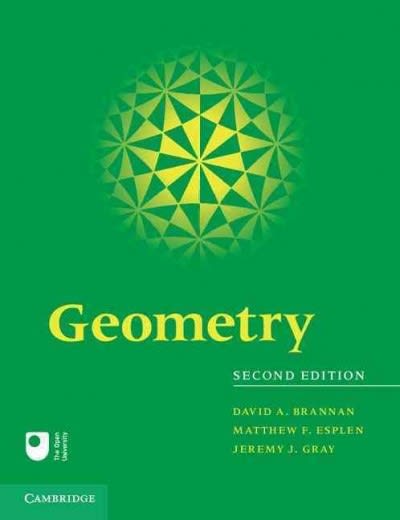Question
Assignment #1: Descriptive Statistics Data Analysis Before conducting any statistical analyses, researchers develop a plan for how they will obtain and analyze data to answer
Assignment #1: Descriptive Statistics Data Analysis
Before conducting any statistical analyses, researchers develop a plan for how they will obtain and analyze data to answer their research question. The purpose of this assignment is to provide experience working with and executing a descriptive statistics analysis plan using real world data to answer a practical question.
In the first assignment you will execute the descriptive analysis plan using the provided data to create tables and graphs to focus your effort in determining a point estimate of the parameter in question. The second assignment, address Inferential Statistics, expanding the analysis of first assignment to include a confidence interval to the point estimate obtained in Assignment 1.
Assignment Plan
Identify 7 Subjects with similar attributes of your client and determine their average expenditures.Upon request and instructor approval you may use a profile of your choice.
Understanding the task to be addressed:
You are a Financial Advisor and have been asked to perform the following task:
Using provided real world data determine the budgetary annual expenditure your client should anticipate, assuming your client has the following social/economic family profile.
Profile:
Family Income$97,000.00
Marital StatusSingle
Family SizeFour (4)
AgeFifty-Three (53)
Project Approach
Identify 7 Subjects with attributes similar too your clients and determine their average expenditures. The average expenditures will be the point estimate
Similar attributes: salary, marital status, family size and age
Step #1: Review the provided random sample data set.
The data provided is a subsample from the US Department of Labor's Consumer Expenditure Surveys (CE) and provides information about the composition of households and their annual expenditures (https://www.bls.gov/cex/). Detailed information on the sample and variables is included with the data set file; please carefully review this information to familiarize yourself with the data.For your convenience the data set is also provided in an Excel spreadsheet.
Note: This data set will be used for both written assignments.
Step #2: Complete the following Table
Variable Categorize* Minimum Maximum Mean Shape **Outliers***
Income
Age
Family Size
Annual Expenditures
*Abbreviations: Qual. for Qualitative data (categorical), Quant for Quantitative data
**Left, Right, Symmetrical (Sym.)
***Identify outliers by Id number or 0
Step 3:Graphs (Dot plot, Histogram and a Box and Whisker plot) for the following variables
Income vs Marital Status
Annual Expenditures vs Income
Describe at least one important characteristic observed from each group of graphs. Recommend-lock5stat.com-Statkey for graphing-and MS Snipping tool for pasting .
Step 4Based upon the data provided:Provide 7 or more subjects that best represent your client's social/economic lifestyle.If one or more of the 7 recommended subjects is a 'push', a possible outlier, identify the outlier or outliers by placing a * in the Outlier column.
Id # of Subject Chosen Marital Status Income Family size Age Outlier
Step 5Explain in bullet form, in a clear and orderly procedure: the method used (in step format) for determining your recommended list of subjects.
Step 6Point Estimate Recommendation:
Based upon your analysis what do you believe the Annual Expenditures of your Client will be.
DATA
Unique ID # SE-Marital Status SE-income SE-Age Head of Household SE-FamilySize USD-AnnualExpenditures USD-Housing USD-Electricity USD-Water
1 Not Married 94,929 59 2 55,247 18,483 1,451 546
2 Not Married 96,621 54 2 55,746 18,149 1,455 540
3 Not Married 96,664 53 3 55,558 18,502 1,478 553
4 Not Married 96,522 43 4 56,152 18,483 1,457 537
5 Not Married 96,697 49 2 56,453 18,520 1,469 545
6 Not Married 96,727 39 2 56,440 18,376 1,441 542
7 Not Married 94,867 60 1 55,512 18,633 1,485 523
8 Not Married 96,690 57 2 56,097 18,334 1,453 535
9 Not Married 97,469 35 4 54,929 18,514 1,451 565
10 Not Married 96,886 44 2 55,321 18,312 1,450 523
11 Not Married 95,744 52 4 55,963 18,435 1,465 555
12 Not Married 96,572 59 2 56,515 18,648 1,480 552
13 Not Married 95,366 48 2 57,082 18,576 1,478 538
14 Not Married 97,912 49 1 55,704 18,619 1,450 553
15 Not Married 96,928 43 3 55,932 18,701 1,479 520
16 Married 114,051 42 5 84,486 25,728 1,452 818
17 Married 106,627 56 3 82,676 22,414 1,688 709
18 Married 109,312 37 6 80,801 25,392 1,514 743
19 Married 103,144 29 5 75,393 26,322 1,386 626
20 Married 111,195 30 5 80,865 25,018 1,481 796
21 Married 112,559 39 3 80,934 25,531 1,504 794
22 Married 97,835 30 5 77,765 27,949 1,297 641
23 Married 100,693 42 2 73,294 26,102 1,354 597
24 Married 95,385 50 4 74,110 22,847 1,302 684
25 Married 100,350 31 5 73,771 26,853 1,405 585
26 Married 95,922 55 3 72,228 22,996 1,326 674
27 Married 96,207 27 3 74,620 28,491 1,310 588
28 Married 97,663 51 3 72,971 23,150 1,320 689
29 Married 100,565 18 3 69,203 27,950 1,358 626
30 Married 97,977 44 2 73,198 22,990 1,298 696
Step by Step Solution
There are 3 Steps involved in it
Step: 1

Get Instant Access to Expert-Tailored Solutions
See step-by-step solutions with expert insights and AI powered tools for academic success
Step: 2

Step: 3

Ace Your Homework with AI
Get the answers you need in no time with our AI-driven, step-by-step assistance
Get Started


